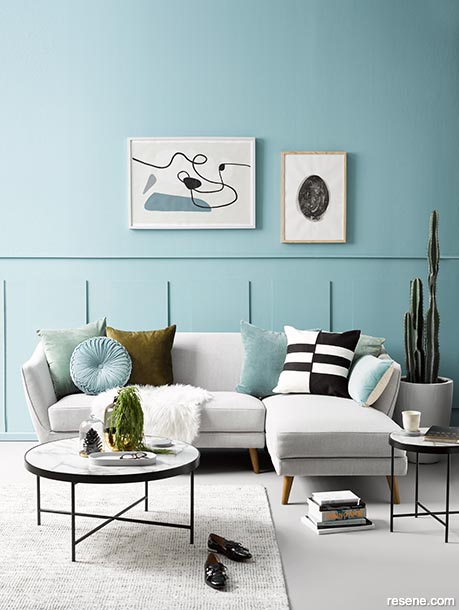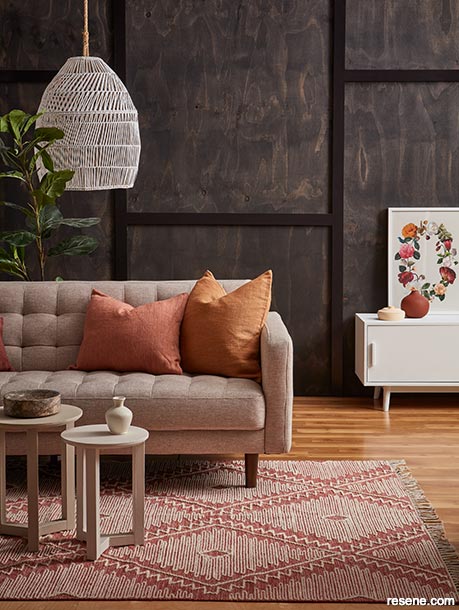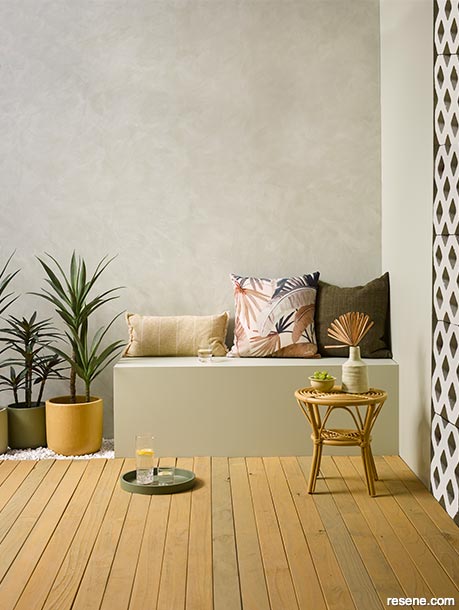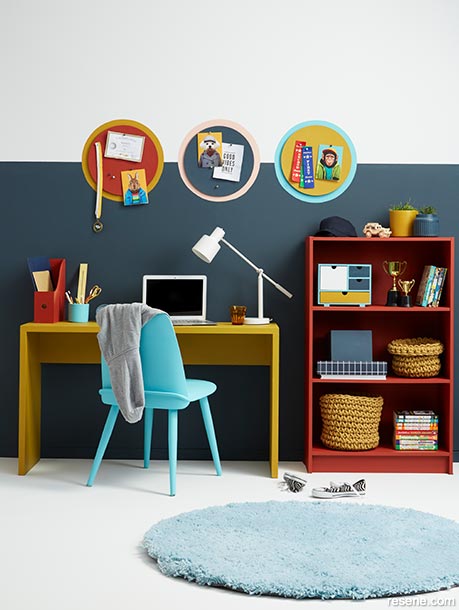From the Resene decorating blog
Never mixing warm and cool colours feels like one of those unbreakable rules of interior design; or at least one that’s best left to the experts.
Good news! You can absolutely mix warm and cool colours in your design palette, and in fact you should do this, to create a finished space that feels balanced and comfortable.
Here are some tips and tricks to start messing with the colour universe.

Warm earthy green accents and fresh neutrals really allow this living room with its cooler sky blue rear wall in Resene Ziggurat to soar.
Walls complemented by floor painted in Resene Mountain Mist, tall planter in Resene Alabaster, coasters in Resene Rolling Stone, oval tray in Resene Half Duck Egg Blue, shorter plant pot in Resene Celeste and DIY artwork in Resene Celeste, Resene Nocturnal, Resene Rolling Stone, Resene Blue Bayoux and Resene Alabaster with a frame in Resene Half Duck Egg Blue. Tables, sofa, rug and cushions from Nood. Project by Laura Lynn Johnston, image by Wendy Fenwick.

The caramel tones of floorboards enhanced by Resene Colorwood Natural stain bring immediate warmth to this lounge.
The brush-stroked finish of the rear wall in Resene Colorwood Sheer Black elevates an inexpensive material such as plywood while adding a cool, desaturated effect. The battens on the wall are painted in Resene All Black with a pendant lightshade in Resene Black White. The sideboard is cool Resene Snow Drift and nest tables in warmer (left to right) Resene Bison Hide, and Resene Quarter Drought. Vase on small table painted in Resene Quarter Drought, on the sideboard lidded dish in Resene Tequila and vase and round case in Resene Half Hairy Heath. Sofa from Nood, rug from Adairs, cushion covers, throw and dish from Citta, artwork by Cloud 9 Creative (Lee Sinclair) from endemicworld, shoes from H&M. Project by Laura Lynn Johnston, image by Wendy Fenwick.
One of the most important non-rules about unconventional colour matching is to not get too caught up with what should go with what at the theoretical level.
Test and learn is the way to go. In fact, the less you know what you ‘should’ or ‘shouldn’t’ do in terms of colour the freer you are to experiment simply with what you like.
Get yourself some Resene testpots, some A3 or A4-sized white paper or card and try mixing and matching your colours. Try them in different rooms, in different lights, and different times of the day to get a clear vision of what your finished space will look like. Your eyes will soon tell you what you like and don’t like. Whether it ‘goes together’ isn’t really for anybody else to say. However, if your colour confidence needs a boost, your local Resene Colour Consultant will also be able to help advise or you can ask for free advice from the Resene Colour Expert online.
Top tip: Leave a 2cm white border around each testpot swatch so you get a true idea of the colour that is not influenced by the current colour of your walls.
It’s also a smart idea to actually choose your colour scheme only once you have key pieces of furniture in place in your chosen room. It is much easier (and cheaper) to find paint colours to suit your favourite couch or piece of art, than it is to find a couch or art you love in the perfect shade to match your walls.
Doing things this way also means your colour palette and surrounding design choices will come together more organically, based around the furniture piece at the heart of your concept. You’ll start to see what colours just look good with each other and your belongings, without worrying too much about warm or cool.

The coolness of this concrete patio corner is given a touch of softness and sunshine with the use of Resene Woodsman Uluru on the decking.
It works well with the added greenery from the plants and the touch of Resene Teak on the table and large plant pot. The back wall is given added interest in grey-green Resene Aspiring with Resene FX Paint Effects Medium mixed with Resene Moon Mist. The breeze block sidewall and the small vase on the table are also in Resene Moon Mist. The bench seat is Resene Aspiring and the smaller planter is Resene Siam. Cushions from Allium Interiors and Shut the Front Door. Project by Vanessa Nouwens, image by Wendy Fenwick.

Colour is king in this study zone, which beautifully mixes warm and cool colours to great effect.
The lower half of the wall is painted in Resene Coast, while the top half and the floor are Resene Poured Milk. Desk in Resene Influential, chair in Resene Yes Please, bookshelf and magazine file in Resene Raging Bull, plant pots on the bookshelf in Resene Influential and Resene Coast, mini drawer unit in Resene Poured Milk, Resene Yes Please, Resene Coast and Resene Influential, wooden box in Resene Coast, pencil pot in Resene Yes Please, circles painted on the wall in (from left) Resene Influential, Resene Shilo and Resene Yes Please with cork placemats used as pin boards in (from left) Resene Raging Bull, Resene Coast and Resene Influential. Rug and alarm clock from Allium, stationery accessories all from The Warehouse, glass and baskets from Citta. Project by Vanessa Nouwens, image by Bryce Carleton.
Generally speaking, cool colours are blues, greens and purples, while warm colours are reds, oranges and yellows. However, it is possible to have a cool colour with a warm undertone and vice versa. For example yellows tinted with green will be cooler than yellows tinted with orange. Blues tinted with reds will be warmer than blues tinted with greens.
The aqua/teal colour spectrum is a good example of this because it takes in such a wide range of colours. Resene Reservoir is a cool pastel aqua green, while Resene Billabong is a deep oily teal with warm undertones. They work together because they come from a similar green/blue section of the colour wheel, yet one is warm and one is cool.
At first glance it might seem as though warm simply means darker colours, while lighter shades are cooler. But dark shades like steely grey Resene Tuna are cool while soft orange Resene Sunshade is warm.
This mixing is what gives different shades of colours, and frees us all up to play with a huge spectrum of colour combinations.
Don’t get too caught up in the maths and proportions of colour mixing. It can get overwhelming and lead to what’s affectionately known as ‘paint paralysis’ where you’re overthinking the theory instead of trusting your colour instincts.
Top tip: Cool-toned dark colours will recede from the eye making smaller spaces feel larger.
Warmth and coolness can play a slightly more important role if you’re opting for a largely neutral backdrop to your space using Resene’s range of whites and neutrals.
There are cool whites, such as Resene Black White and Resene Sea Fog, which will make your space feel crisp and bright, and warm whites, such as Resene Merino and Resene Half Pearl Lusta, which have a softer, more yellowy or creamy tone. Cool whites work well in modern interiors with lots of windows and work well in bright, sunny rooms. Warmer whites work well in colder rooms and often suit older homes with smaller windows. Warmer shades are also a little more forgiving on less than perfect surfaces.
You can definitely layer different shades of white or neutral in a room, but it works best when those shades are either all warm, or all cool. Resene also has some green-based whites which can shift between cool and warm depending on other colours and light around them. Some of these include Resene Quarter Linen and Resene Rice Cake.
What you can do however is add bold highlights of an impact colour against your neutral backdrop, and that’s where you can experiment more with mixing cool and warm shades. Try deep Resene Cab Sav with cool Resene Concrete.
Hot tip: The Resene Whites and Neutrals collection is a good place to start your white on white plans. You can see how all the different tones work together, and see the difference between warm and cool shades.
Using natural wood finishes on trim features of your home can add immediate warmth to otherwise cool shades.
An unexpected but sophisticated combination to try is Resene Colorwood Natural for interiors or Resene Woodsman Natural for exteriors with a cool toned grey such as Resene Half Stack. Highlights of white in classic Resene Alabaster add extra brightness or you could soften and warm it up with creamier Resene Bianca.
Overall colour proportion. Too much of a single colour can dominate and throw off your colour pairing. A 60-30-10 split between three colours is a good place to start.
Aim for a good balance of light, mid and deep tones to keep your room visually interesting and comfortable to be in.
Natural vs artificial light. Your light sources will make a big difference to how your colours play off each other, so experiment with Resene testpots before you commit.
When you’re introducing an accent colour, try and use it in three places – this might be a feature wall, an ornament and flowers.
The key when choosing a colour palette is to choose something that suits you and your family and the way you want to live in your home. Take inspiration from the latest trends and what you see online for fresh ideas to consider, then narrow the options down to those that you truly love.


June 24, 2022
Visit your local Resene ColorShop for expert advice and all the products and accessories you need to make the most of your home.
Book a colour consult | Ask a Colour Expert | Ask a Paint Expert
Resene's decorating blog
Paint your home beautiful! Discover the latest decorating trends, tips and colour news.